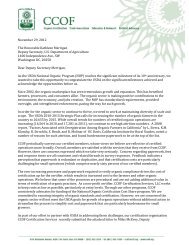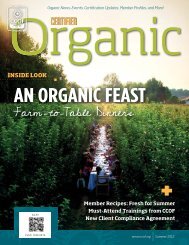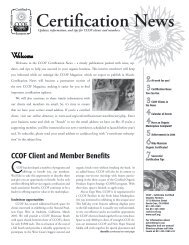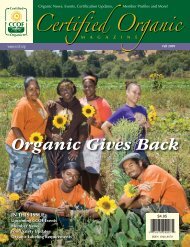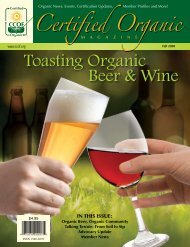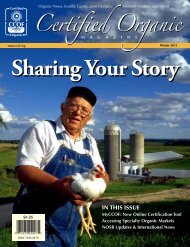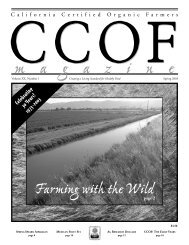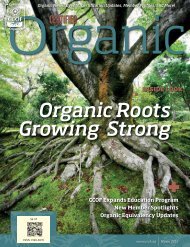Herstory: Women in Organic Agriculture - CCOF
Herstory: Women in Organic Agriculture - CCOF
Herstory: Women in Organic Agriculture - CCOF
You also want an ePaper? Increase the reach of your titles
YUMPU automatically turns print PDFs into web optimized ePapers that Google loves.
Cecilia Garcia, Donna Olson & Jackie Cooper<br />
NPO (NURSES PISTACHIO ORCHARD) • SAN LUIS OBISPO CHAPTER<br />
IN PREPARATION TO RETIRE<br />
from nurs<strong>in</strong>g <strong>in</strong> the Southern California<br />
area, three friends decided to purchase<br />
land on the California coast just north of<br />
San Luis Obispo. Hav<strong>in</strong>g no luck <strong>in</strong> f<strong>in</strong>d<strong>in</strong>g<br />
the perfect spot, these three friends<br />
were directed to Paso Robles, where they<br />
did f<strong>in</strong>d that perfect spot on some hilltop<br />
land. But they hadn’t yet decided what to<br />
plant and what to call their new home.<br />
In Southern California, Jackie Cooper<br />
taught <strong>in</strong> a Registered Nurses program at<br />
Long Beach City College. Donna Olson<br />
worked at Long Beach Memorial Hospital,<br />
and Cecilia Garcia worked at Pacific Hospital<br />
of Long Beach. Cecilia, or Ce as she is<br />
known by her friends, cont<strong>in</strong>ues to work<br />
part-time at Tw<strong>in</strong> Cities Hospital <strong>in</strong> Templeton.<br />
These three nurses knew they did<br />
not want to retire <strong>in</strong> the LA area, and they<br />
also knew they did not want to sit around<br />
and do noth<strong>in</strong>g <strong>in</strong> their retirement. What<br />
they wanted was to retire <strong>in</strong> the outdoors.<br />
What to do then? Start a farm.<br />
With the first 10-acre parcel purchased<br />
<strong>in</strong> 1981, the women decided to plant pistachios,<br />
partly because the competition <strong>in</strong> the<br />
area was fairly m<strong>in</strong>imal, and they thought<br />
that ma<strong>in</strong>ta<strong>in</strong><strong>in</strong>g an orchard would be<br />
easier than manag<strong>in</strong>g ground crops. Thus,<br />
NPO (Nurses Pistachio Orchard) was born.<br />
In 1985 they purchased a second 10-acre<br />
parcel adjacent to their land. S<strong>in</strong>ce they had<br />
not yet retired, they cont<strong>in</strong>ued to visit the<br />
land and care for the orchard. It wasn’t until<br />
1997 that Jackie, Donna, and Ce retired<br />
from nurs<strong>in</strong>g and moved to their new home<br />
they had built on the land.<br />
Like many farmers, they learned from<br />
their peers and they also just learned by<br />
do<strong>in</strong>g. But for their first substantial harvest,<br />
they learned a different way to harvest<br />
from a more experienced laborer they had<br />
hired. The three nurses discovered that<br />
rather than pick each nut as they had<br />
thought, they need to lay tarps under each<br />
tree. Next they hit each tree with a mallet<br />
to cause the ripe nuts to fall on the tarp,<br />
from which they gather the nuts and place<br />
them <strong>in</strong> conta<strong>in</strong>ers. They then haul and<br />
dry the nuts. They hire one or two laborers<br />
Page 10<br />
to help with the harvest, but mostly rely on<br />
many of their friends and family who come<br />
to help out with work and celebration.<br />
From their present orchard of 2200 trees,<br />
9000 pounds of pistachios were harvested<br />
this past season, out of which nearly 3000<br />
pounds of split and dried nuts were<br />
obta<strong>in</strong>ed. Approximately 40–50 trees are<br />
“We’re very blessed to be here.”<br />
replanted each year, hav<strong>in</strong>g succumbed to<br />
deer, ground squirrels and gophers.<br />
The nurses found themselves at a disadvantage<br />
grow<strong>in</strong>g pistachios near the coast.<br />
Growers <strong>in</strong> the Central Valley are ready to<br />
harvest their pistachios about one month<br />
before those growers <strong>in</strong> the Paso Robles<br />
area. This can make it harder for the coastal<br />
growers to f<strong>in</strong>d a market for their crops,<br />
and the nurses have had this experience<br />
themselves. But their crop was different,<br />
and one <strong>in</strong> which many consumers at first<br />
didn’t seem <strong>in</strong>terested, but grew to love.<br />
The nurses harvest and simply dry their<br />
pistachios. The nuts are neither salted nor<br />
roasted. Just prior to this past harvest, their<br />
broker backed out on them, and they<br />
feared they would not be able to f<strong>in</strong>d a<br />
market for their crop. Instead, another<br />
market, a farmers’ market, was just what<br />
they found. Their North County Farmers’<br />
Market accepted the nurses and their crop,<br />
and the public loved the simply dried/no<br />
salt/no roast pistachio nuts. Even natural<br />
foods stores <strong>in</strong> San Luis Obispo started carry<strong>in</strong>g<br />
their dried nuts. These new farmers<br />
had found their niche.<br />
Gett<strong>in</strong>g to that po<strong>in</strong>t was not so easy.<br />
There were many challenges to face, yet they<br />
did not f<strong>in</strong>d any overt prejudice aga<strong>in</strong>st<br />
them be<strong>in</strong>g women. Their neighbors were<br />
very helpful, they say, and so were their<br />
laborers and families. In particular, one 82-<br />
year old man, Bob Thimm, has helped them<br />
ma<strong>in</strong>ta<strong>in</strong> their orchard and overcome many<br />
of their farm<strong>in</strong>g challenges. Bob had previously<br />
been the manager for a large ranch<br />
that existed <strong>in</strong> the area before it was subdivided.<br />
He more than anyone <strong>in</strong> the area was<br />
most familiar with the land and its needs.<br />
Tend<strong>in</strong>g to the farm is a job shared by<br />
all. Jackie takes care of much of the plann<strong>in</strong>g<br />
and organiz<strong>in</strong>g. Donna tends to<br />
mechanical duties, runs the tractor and<br />
ATV, and reviews paperwork. Ce tends<br />
to market<strong>in</strong>g of their pistachios and is<br />
jok<strong>in</strong>gly referred to by the three women as<br />
“the laborer.” All three do their fair share<br />
of work <strong>in</strong> the field, check<strong>in</strong>g tree health,<br />
pest damage, and irrigation l<strong>in</strong>es. In one<br />
way, farm<strong>in</strong>g wasn’t so different from nurs<strong>in</strong>g.<br />
Bob has taught these women many<br />
th<strong>in</strong>gs about farm<strong>in</strong>g, but they were quick<br />
to understand irrigation. “It’s a lot like an<br />
IV l<strong>in</strong>e [<strong>in</strong>travenous],” they say.<br />
When it came to gett<strong>in</strong>g the orchard<br />
certified, they looked no further than<br />
<strong>CCOF</strong>. But why choose to become<br />
organic? Jackie and Ce had been raised<br />
rurally, and Donna had worked on her<br />
family’s farm until the age of 13. In their<br />
years of periodic commut<strong>in</strong>g between their<br />
Southern California nurs<strong>in</strong>g jobs and their<br />
new land <strong>in</strong> Paso Robles, Jackie, Donna,<br />
and Ce often saw airplanes spray<strong>in</strong>g fields<br />
with pesticides, and they didn’t like what<br />
they saw. It was also their experiences as<br />
nurses that helped them decide to grow<br />
organically; see<strong>in</strong>g the variety of sick people<br />
<strong>in</strong> the hospital and often know<strong>in</strong>g<br />
what may have put them there.<br />
Look<strong>in</strong>g out from the d<strong>in</strong><strong>in</strong>g room at<br />
the beautiful view of their orchard and surround<strong>in</strong>g<br />
hills, Jackie says with a smile of<br />
satisfaction on her face, “We’re very blessed<br />
to be here.”<br />
The Newsletter of <strong>CCOF</strong>





